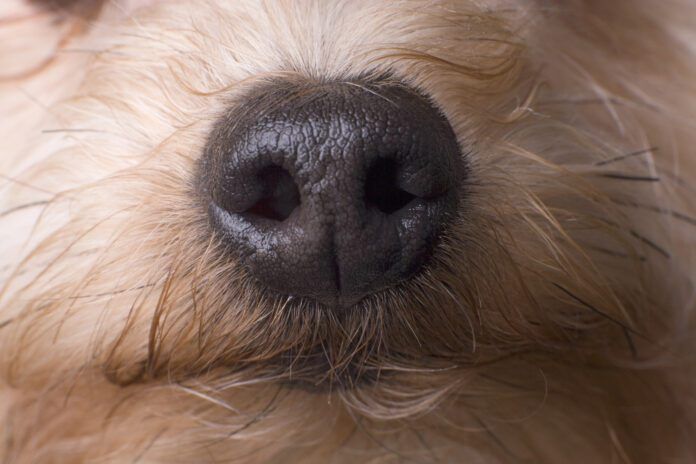Those of us who live with and love dogs, know they’re remarkable creatures. We’ve only recently begun to learn just how remarkable they are. With about 220 million scent receptors (compared to our own puny 5 million), dogs can smell things that are impossible for us to detect. By virtue of that astounding sense of smell, dogs have been trained to identify dozens of substances including drugs, explosives, arson accelerants, and human remains. In fact, we know that dogs can distinguish the smell of a rodent from up to 160 feet away, a wild tortoise from 200 feet away, decaying flesh from 600 feet away, and whale scat from more than a mile away.[i]
Countless studies also show that dogs can detect certain diseases like Parkinson’s and SARS-CoV-2, along with the onset of conditions such as seizures, low or high blood sugar in diabetics, and migraines. Now, mounting evidence suggests that dogs can also play a part in detecting human cancer.
But how is it that dogs can detect illness—specifically cancers—simply through scent?
The Scent of Disease
It all goes back to the makeup of the human body. Our bodies, along with almost everything else in our environment, emit volatile organic compounds (VOCs), a medley of organic chemicals that vaporize at room temperature and disperse in the air. Human beings continuously emit hundreds of VOCs through normal biological and physiological processes, such as when we ingest food or by the breakdown of certain bacteria in our bodies (for instance, the odor produced by sweat).[ii]
It was Hippocrates who, around 450 BCE, first identified several disease-specific odors in urine and sputum. But it took until the beginning of the 19th century before scientists began investigating the link between human odors and disease, and discovered that disease-related VOCs can diffuse throughout the tissue and be expelled in breath, feces, vaginal secretions, skin, sweat, urine, and blood.[iii],4 By the second half of the 20th century, gas chromatography and mass spectroscopy were being used to separate VOCs and identify cancer-specific substances in these human excretions.[iv]
How Dogs Sense Cancer
Then dogs entered the scene. The first known instance of a dog being able to detect cancer came in 1989, when two British dermatologists reported on how a patient’s dog repeatedly sniffed at a lump on her leg, even through her clothing, eventually prompting the woman to see her doctor. The lump turned out to be malignant melanoma.[v]
At first, scientists were skeptical, treating this anecdote for what it was: an anecdote. It wasn’t until the early 2000s that their interest began to overcome their skepticism, when additional studies validated earlier suspicions that dogs could indeed sniff out cancer. This included a 2004 experimental study which found that dogs’ ability to detect bladder cancer in urine was greater than would be expected by chance alone. Further, much to the researchers’ surprise, the dogs kept identifying the urine of one healthy participant as being positive for cancer. Concerned, the person’s doctor ordered additional tests and found that this “healthy” individual in fact had very early-stage kidney cancer.[vi]
In 2006, the first of what were to become dozens of high-quality, double-blind studies was published. (In a double-blind study, neither the dogs nor their handlers know which samples are cancerous.) In this first study, breath samples were taken from 55 lung cancer patients and 31 breast cancer patients. Specialized instruments were unable to detect anything in these patients’ exhaled breath . . . and yet dogs identified 99 percent of the lung cancers and between 88 and 98 percent of the breast cancers.[vii]
In the intervening years, an increasing number of studies have investigated the ability of dogs to accurately detect lung, breast, ovarian, bladder, and prostate cancer.[viii] For instance, in 2021, a British research team held a clinical trial with 246 patients ranging in age from 45 to 80 years, 41 of whom had been diagnosed with various stages of lung cancer. (The remainder were healthy individuals with no history of cancer.) In combined test results of both breath and urine, the dog correctly identified 40 of 41 cancer samples.[ix]
That same year, a multi-national team of scientists demonstrated that dogs can be trained to detect the most aggressive and lethal form of prostate cancer from VOCs.
The Dog’s Role in Early Cancer Diagnosis
Speaking of the prostate cancer study, Dr. Claire Guest, Chief Scientific Officer of Medical Detection Dogs said, “This study showed that a dog’s nose could hold the key to an urgently needed, more accurate, and non-invasive method of early prostate cancer diagnosis.”[x]
The need for accurate, early diagnosis of all cancers is equally urgent. Cancer is the second major cause of death worldwide. According to the National Cancer Institute, by 2040, the worldwide number of new cancer cases per year is expected to rise to almost 30 million, and the number of cancer-related deaths to more than 15 million.[xi] Early diagnosis is the single most effective way to reduce the risks associated with cancer and enable cancer victims to have the best chance for successful treatment and survival.[xii]
Despite all the strides that have been made over the last 40 years in the fight against cancer, early detection and intervention efforts are still lacking. The dog’s nose is playing an important role in the attempt to identify cancer earlier, once again proving that a dog is indeed a human’s best friend.
[i] Kokocińska-Kusiak, Agata et al. “Canine Olfaction: Physiology, Behavior, and Possibilities for Practical Applications.” Animals Journal, 11(8), 2463. August 21, 2021. https://doi.org/10.3390/ani11082463 (from National Library of Medicine Pub Central. https://pmc.ncbi.nlm.nih.gov/articles/PMC8388720/)
[ii] Irga, Peter. J et al. “Volatile organic compounds emitted by humans indoors– A review on the measurement, test conditions, and analysis techniques.” Building and Environment Volume 255, May 1, 2024. https://doi.org/10.1016/j.buildenv.2024.111442 (Accessed through ScienceDirect. https://www.sciencedirect.com/science/article/pii/S0360132324002841#bib29 )
[iii] Bauër, Pierre, PhD et al. “Remote Medical Scent Detection of Cancer and Infectious Diseases With Dogs and Rats: A Systematic Review” Integrative Cancer Therapies, Volume 21; January-December 2022. (Accessed through Sage Journals: https://journals.sagepub.com/doi/10.1177/15347354221140516 )
[iv] Shirasu, Mika, and Touhara, Kazushige. “The scent of disease: volatile organic compounds of the human body related to disease and disorder.” The Journal of Biochemistry, Volume 150, Issue 3, September 2011. https://doi.org/10.1093/jb/mvr090
[v] Williams, Hywel, and Pembroke, Andres Pembroke. “Sniffer Dogs in the Melanoma Clinic?” The Lancet, Volume 333, Issue 8640, 1989. https://doi.org/10.1016/S0140-6736(89)92257-5 (Referenced in “Man’s best friend and potent medical ally.” International Myeloma Foundation. Oct 12, 2017. https://www.myeloma.org/blog/dr-duries/mans-best-friend-potent-medical-ally )
[vi] Willis, Carolyn M. et al. “Olfactory detection of human bladder cancer by dogs: proof of principle study.” British Medical Journal, 329(7468):712. Sept 25, 2004. https://doi.org/10.1136/bmj.329.7468.712. (Accessed through National Library of Medicine, PubMed Central. https://pmc.ncbi.nlm.nih.gov/articles/PMC518893/
[vii] McCulloch, M. et al. “Diagnostic accuracy of canine scent detection in early-and late-stage lung and breast cancers.” Integrative Cancer Therapies, Vol 5, No 1: March 2006. (Accessed through Sage Publications. https://citeseerx.ist.psu.edu/document?repid=rep1&type=pdf&doi=2a5c48717cb83d95afde982af8059deef9f4f1b9 )
[viii] Guest, Claire et al. “Feasibility of integrating canine olfaction with chemical and microbial profiling of urine to detect lethal prostate cancer.” PLOS ONE. February 17, 2021. https://journals.plos.org/plosone/article?id=10.1371/journal.pone.0245530&nocache
[ix] Feil, C., et al. “Sniffer dogs can identify lung cancer patients from breath and urine samples.” BMC Cancer 21, 917 (2021). https://doi.org/10.1186/s12885-021-08651-5
[x] Guest, Claire. loc sit
[xi] No author given. “Cancer Statistics.” National Institutes of Health, National Cancer Institute. May 9, 2024. https://www.cancer.gov/about-cancer/understanding/statistics
[xii] No author given. “Promoting cancer early diagnosis.” World Health Organization. No date given. https://www.who.int/activities/promoting-cancer-early-diagnosis






